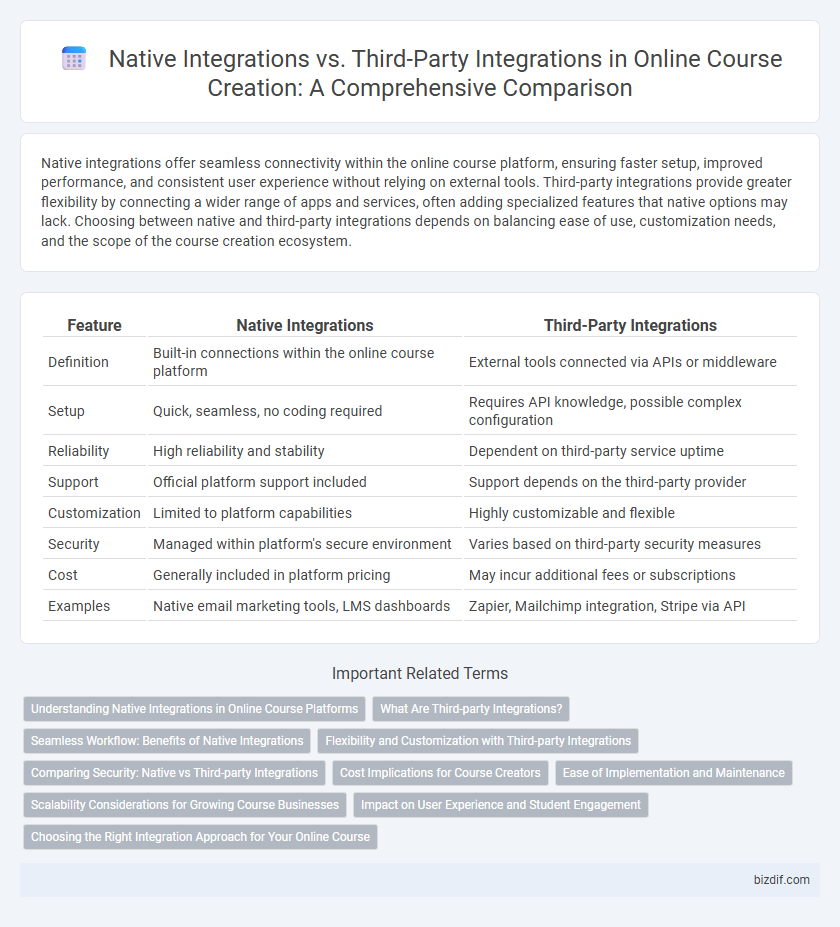Native integrations offer seamless connectivity within the online course platform, ensuring faster setup, improved performance, and consistent user experience without relying on external tools. Third-party integrations provide greater flexibility by connecting a wider range of apps and services, often adding specialized features that native options may lack. Choosing between native and third-party integrations depends on balancing ease of use, customization needs, and the scope of the course creation ecosystem.
Table of Comparison
| Feature | Native Integrations | Third-Party Integrations |
|---|---|---|
| Definition | Built-in connections within the online course platform | External tools connected via APIs or middleware |
| Setup | Quick, seamless, no coding required | Requires API knowledge, possible complex configuration |
| Reliability | High reliability and stability | Dependent on third-party service uptime |
| Support | Official platform support included | Support depends on the third-party provider |
| Customization | Limited to platform capabilities | Highly customizable and flexible |
| Security | Managed within platform's secure environment | Varies based on third-party security measures |
| Cost | Generally included in platform pricing | May incur additional fees or subscriptions |
| Examples | Native email marketing tools, LMS dashboards | Zapier, Mailchimp integration, Stripe via API |
Understanding Native Integrations in Online Course Platforms
Native integrations in online course platforms offer seamless connectivity with built-in tools such as payment gateways, email marketing, and analytics, enhancing user experience and reducing setup time. These integrations are optimized for compatibility and performance within the platform, ensuring reliable functionality and streamlined workflows. Leveraging native integrations minimizes technical issues and supports consistent updates aligned with platform enhancements.
What Are Third-party Integrations?
Third-party integrations in online course creation refer to external tools and services that can be connected to a learning management system (LMS) to enhance functionality, such as payment gateways, email marketing platforms, and analytics software. These integrations expand course capabilities beyond native features by allowing seamless automation, improved user experience, and advanced data tracking. Utilizing third-party integrations enables course creators to customize their platform with specialized tools that cater to specific business needs or learner preferences.
Seamless Workflow: Benefits of Native Integrations
Native integrations streamline online course creation by embedding tools directly within the platform, ensuring faster data synchronization and reducing the risk of errors. They eliminate compatibility issues often seen with third-party integrations, enhancing overall system reliability and user experience. This seamless workflow boosts instructor productivity by minimizing setup time and facilitating automated processes like enrollment, grading, and content updates.
Flexibility and Customization with Third-party Integrations
Third-party integrations offer greater flexibility and customization compared to native integrations by allowing course creators to connect a wide range of external tools and platforms. This enables tailored workflows, access to specialized features, and the ability to adapt the online course environment to specific educational needs. Leveraging APIs and plugins, third-party integrations enhance the overall functionality and user experience beyond the limitations of built-in software options.
Comparing Security: Native vs Third-party Integrations
Native integrations in online course platforms typically offer enhanced security by being built directly into the system, reducing vulnerabilities associated with external data exchange. Third-party integrations can introduce additional risks due to reliance on external APIs and varying security protocols, making them more susceptible to data breaches and unauthorized access. Evaluating the security measures, such as encryption standards and compliance certifications, is essential when choosing between native and third-party integrations for course creation tools.
Cost Implications for Course Creators
Native integrations in online course platforms typically offer cost-effective solutions since they are included in the subscription fee, reducing the need for additional expenses. Third-party integrations often involve extra fees, such as monthly charges or transaction-based costs, which can significantly increase the overall budget for course creators. Carefully evaluating the cost structure of both integration types is essential for maximizing return on investment and minimizing unexpected expenditures in course development.
Ease of Implementation and Maintenance
Native integrations in online course platforms offer seamless ease of implementation and low maintenance since they are built into the system's core infrastructure, minimizing compatibility issues. Third-party integrations often require additional setup time and ongoing troubleshooting due to external dependencies and updates outside the platform's control. Choosing native integrations reduces technical complexity and ensures smoother course delivery with less downtime.
Scalability Considerations for Growing Course Businesses
Native integrations offer seamless scalability for growing course businesses by providing direct compatibility with the platform's core features, ensuring faster updates and reliable performance. Third-party integrations may introduce flexibility by connecting a wider range of tools but can pose challenges in scalability due to potential API limitations and dependency on external providers. Evaluating integration options based on long-term scalability, maintenance, and vendor support is crucial for sustaining growth in online course environments.
Impact on User Experience and Student Engagement
Native integrations in online course platforms offer seamless access to tools, enhancing user experience by reducing friction and allowing students to stay focused within one interface. Third-party integrations, while expanding functionality, can introduce inconsistencies and potential technical issues that disrupt engagement and increase confusion. Optimizing for native integrations generally leads to higher student retention and smoother course navigation, critical factors for effective online learning.
Choosing the Right Integration Approach for Your Online Course
Native integrations streamline online course creation by offering seamless compatibility with your platform's core features, ensuring faster setup and enhanced functionality. Third-party integrations provide flexibility by connecting diverse tools and services, expanding customization options to tailor the learning experience. Selecting the right approach depends on balancing ease of use, technical requirements, and scalability to optimize course delivery and learner engagement.
Native integrations vs Third-party integrations Infographic

 bizdif.com
bizdif.com